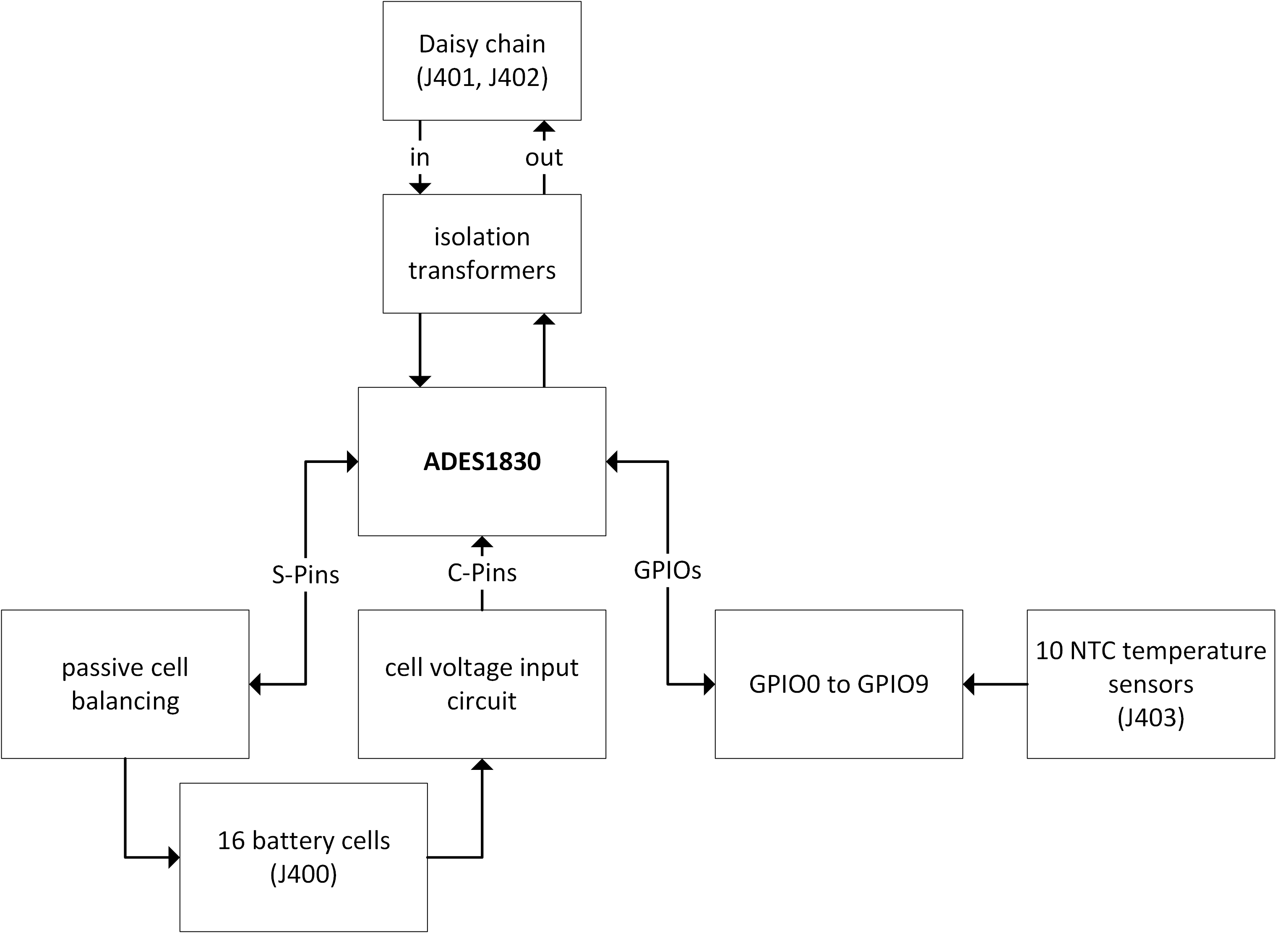5.3.1.2. ADI ADES1830-based 16-Cell Slave v0.9.0
Note
The changelog for this release is found at v0.9.0.
5.3.1.2.1. Overview
Important
The following description only applies for the ADI ADES1830-based 16
cell BMS-Slave hardware version 0.9.0.
Hint
All connector pinouts described below follow the Convention for Molex Micro-Fit 3.0 Connector Pin Numbering.
5.3.1.2.2. Specifications
5.3.1.2.2.1. Electrical Ratings
The current consumption from the module has been measured at 57.6 V module voltage, which is equivalent to a cell voltage of 3.6 V per cell. No sense lines have been connected for this measurement (as the impact of cell voltage sensing is negligible on the current consumption).
Description |
Minimum |
Typical |
Maximum |
Unit |
|---|---|---|---|---|
Battery Module Voltage |
11 |
– |
80 |
V |
Single Battery Cell Voltage |
0 |
– |
5 |
V |
Temperature Sensor Inputs |
– |
10k |
– |
\({\Omega}\) |
Current consumption: AFE active |
– |
TBD |
– |
mA |
5.3.1.2.2.2. Mechanical Dimensions
Description |
Value |
Unit |
|---|---|---|
Width |
100 |
mm |
Length |
160 |
mm |
Height |
15 |
mm |
Weight |
(TBC) 88 |
g |
5.3.1.2.2.3. Block Diagram
The block diagram of the BMS-Slave is shown in Fig. 5.7.

Fig. 5.7 BMS-Slave 16-Cell Block Diagram
5.3.1.2.2.4. Schematic and Board Layout
More information about the board schematic and layout files can be found in section Design Resources.
5.3.1.2.3. Functions
5.3.1.2.3.1. Cell Voltage Measurement
The cell voltage sense lines are input on the connector J400. The pinout is described in Table 5.53.

Pin |
Signal |
Direction |
Description |
|---|---|---|---|
1 |
|
Input |
Battery module negative terminal |
2 |
|
Input |
Cell 0 positive terminal |
3 |
|
Input |
Cell 2 positive terminal |
4 |
|
Input |
Cell 4 positive terminal |
5 |
|
Input |
Cell 6 positive terminal |
6 |
|
Input |
Cell 8 positive terminal |
7 |
|
Input |
Cell 10 positive terminal |
8 |
|
Input |
Cell 12 positive terminal |
9 |
|
Input |
Cell 14 positive terminal |
10 |
|
Input |
Battery module positive terminal |
11 |
not connected |
- |
- |
12 |
not connected |
- |
- |
13 |
|
Input |
Cell 0 negative terminal |
14 |
|
Input |
Cell 1 positive terminal |
15 |
|
Input |
Cell 3 positive terminal |
16 |
|
Input |
Cell 5 positive terminal |
17 |
|
Input |
Cell 7 positive terminal |
18 |
|
Input |
Cell 9 positive terminal |
19 |
|
Input |
Cell 11 positive terminal |
20 |
|
Input |
Cell 13 positive terminal |
21 |
|
Input |
Cell 15 positive terminal |
22 |
not connected |
- |
- |
23 |
not connected |
- |
- |
24 |
not connected |
- |
- |
The VBAT+ and VBAT- connection is used for the internal power supply of the
slave board.
The cell input lines are filtered by differential capacitor filter: both possibilities are provided on the PCB of the BMS-Slave. More information on the corner frequency of this filtering can be found in the schematic. The differential capacitor filter can be used when noise is less frequent or the design is subjected to cost optimization.
5.3.1.2.3.2. Passive Cell Balancing
The passive balancing circuit is realized by a series connection of two 30 \({\Omega}\) discharge-resistors that can be connected to each single cell in parallel. The balancing process is controlled by the ADI ADES1830 monitoring IC. The resistor value of 2x 30 \({\Omega}\) results in a balancing current of about 60 mA at a cell voltage of 3.6 V. This current results in a power dissipation of about 0.2W per balancing channel (at 3.6 V).
5.3.1.2.3.3. Temperature Sensor Measurement
The cell temperature sensors are connected to the connectors J403.
The pinout is described in Table 5.54.

Pin |
Signal |
Direction |
Description |
|---|---|---|---|
1 |
T-SENSOR_0 |
Input |
NTC Sensor 0 terminal 1 |
2 |
T-SENSOR_1 |
Input |
NTC Sensor 1 terminal 1 |
3 |
T-SENSOR_2 |
Input |
NTC Sensor 2 terminal 1 |
4 |
T-SENSOR_3 |
Input |
NTC Sensor 3 terminal 1 |
5 |
T-SENSOR_4 |
Input |
NTC Sensor 4 terminal 1 |
6 |
T-SENSOR_5 |
Input |
NTC Sensor 5 terminal 1 |
7 |
T-SENSOR_6 |
Input |
NTC Sensor 6 terminal 1 |
8 |
T-SENSOR_7 |
Input |
NTC Sensor 7 terminal 1 |
9 |
T-SENSOR_8 |
Input |
NTC Sensor 8 terminal 1 |
10 |
T-SENSOR_9 |
Input |
NTC Sensor 9 terminal 1 |
11 |
|
Input |
NTC Sensor 0 terminal 2 |
12 |
|
Input |
NTC Sensor 1 terminal 2 |
13 |
|
Input |
NTC Sensor 2 terminal 2 |
14 |
|
Input |
NTC Sensor 3 terminal 2 |
15 |
|
Input |
NTC Sensor 4 terminal 2 |
16 |
|
Input |
NTC Sensor 5 terminal 2 |
17 |
|
Input |
NTC Sensor 6 terminal 2 |
18 |
|
Input |
NTC Sensor 7 terminal 2 |
19 |
|
Input |
NTC Sensor 8 terminal 2 |
20 |
|
Input |
NTC Sensor 9 terminal 2 |
Standard 10 \({k\Omega}\) NTC resistors are recommended for use. When using other values than these, the series resistors (R517-R526) on the board may have to be adjusted. Please note that the accuracy of the internal voltage reference VREF2 decreases heavily with a load of over 3 mA. Using 10x 10 \({k\Omega}\) NTC resistors with the corresponding 10 \({k\Omega}\) series resistors results in a current of 1.5mA (at 20 °C) which is drawn from VREF2.
Each 10 temperature sensors are connected to an GPIO pin of the ADI ADES1830.
5.3.1.2.3.4. isoSPI Daisy Chain Connection
The data transmission between the slaves and between the slaves and BMS master uses the isoSPI interface. The isoSPI signals are input/output on the connectors J501/J402. The isoSPI ports are bidirectional, that means they can be used in forward and reverse direction. The isoSPI connections are isolated galvanically using pulse transformers (T500/T501).
The pinout of the isoSPI connectors is described in Table 5.55 and Table 5.56.

Pin |
Daisy Chain |
|---|---|
1 |
|
2 |
|
Pin |
Daisy Chain |
|---|---|
1 |
|
2 |
|
5.3.1.2.4. Software Driver Implementation
The driver implementation for this AFE is documented at ADI ADES1830.
